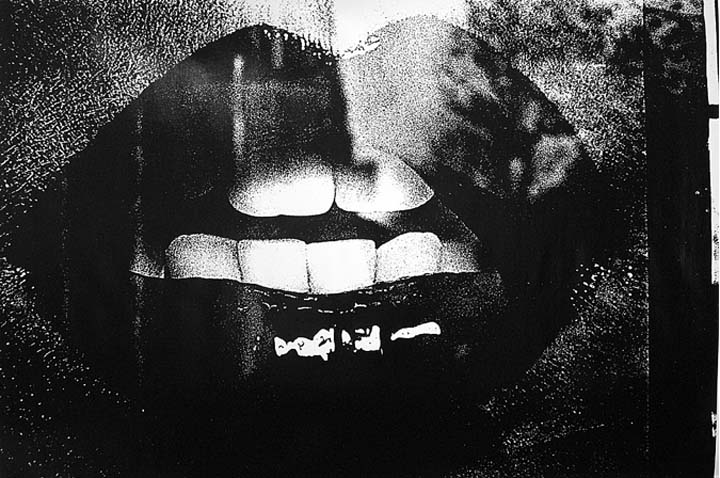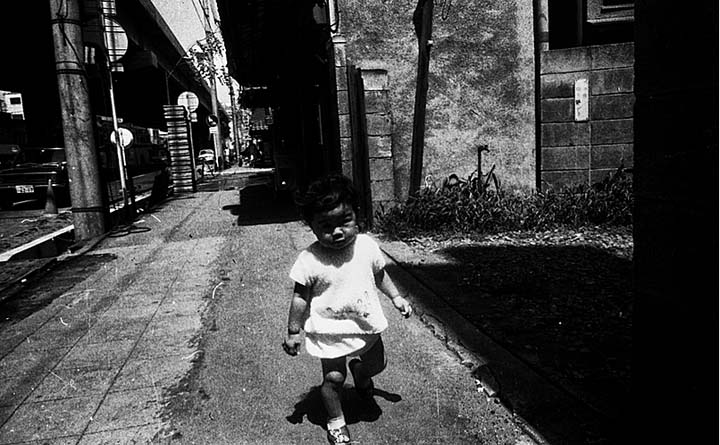Daido Moriyama: Labyrinth
Looking at contact prints from thousands of 35mm black-and-white images by a single photographer might seem like a daunting prospect. But when I finally dove into Daido Moriyama’s Labyrinth (Akio Nagasawa Publishing/Aperture 2012), I was hooked.
The book is a collection of images made by the renowned Japanese photographer from the 1950s onward and rearranged by him to create new visual dialogues. He has selected negative strips shot decades apart, in some cases, to create narratives that further illuminate his extraordinary practice.
Chain link fence along a decaying waterfront strewn with trash; fishnet stockings framed in extreme close-up. Coils of razor-wire marking a boundary; a semi-tropical tree growing flat up against a wall. An unkempt child, a rat, a feral dog. And occasionally, repeats of the red lips, motorcycles, prostitutes, bicycles, and trash that frequently lock his gaze. Everywhere, texture plays off of texture: Hands overlaid on feet; building facades punched with hundreds of windows; a hose coiled on a sidewalk; and hair, all kinds of hair.

Above: Daido Moriyama, Lips, 1989. Silkscreen on canvas. Below: Record No. 2, Japan, 1972. Gelatin silver. Courtesy Steven KasherGallery.
On one spread are five strips of images of the photographer in his youth, shooting self-portraits viewed in an oval mirror; on the opposite page are five strips of snow-covered mountains. Several spreads later, Moriyama, who has so far produced hundreds of photobooks, includes 20 strips of book pages; is he re-editing past work with a view towards a new book project?
Moriyama brings a claustrophobic view to the landscape as well as to his depictions of urban grit. A spread that includes utility lines, a palm tree blowing in a strong wind and a formal garden is intermingled with extreme close-ups of rocks and pebbles that seem like views into a chasm below. On the opposite page are what might be any set of vacation pictures from the tropics, with evidence of bad weather and bored children.
It’s as if Moriyama has created, with Labyrinth, a new index of images for another series of “Printing Shows.” Printing Show—TKY, held at Aperture Gallery in November 2011, was a recreation of Daido Moriyama's 1974 performance of the same name, which took place in a Tokyo storefront and featured images from a trip he had made to New York in 1971. Following the format of the original performance as closely as possible, Printing Show—TKY features photographs made by Moriyama in Tokyo over the past 15 years. It was organized by Ivan Vartanian of Goliga, Tokyo, who staged another recreation of the event for Moriyama’s 2012 exhibition at the Tate Modern, in London.
The large-format book, lushly printed in duotone, in Japan, has a French fold heavy-weight cover that can be set aside while studying the pages. Information.
On Thursday, Steven Kasher Gallery presents Daido Moriyama | Now and Now, in an installation designed by the photographer and featuring a series of images silkscreened on canvas in 2007 as well as iconic images in color and black and white. Steven Kasher Gallery, 521 West 23rd Street, NY, NY.

Daido Moriyama (born in Ikeda, Osaka, 1938) has been publishing and exhibiting his photography since the late 1960s, with a bibliography of over 300 monographs to his name. A major retrospective, Daido Moriyama: Stray Dog, originated in 2000 at the San Francisco Museum of Modern Art, and subsequently toured internationally to the Metropolitan Museum of Art and the Japan Society in New York, Fotomuseum Winterthur in Switzerland, and numerous other venues. He is a recipient of the Cultural Award of the Deutsche Gesellschaft für Photographie, and the 2012 Infinity Award for Lifetime Achievement. Exhibitions include On the Road, a retrospective survey presented at the Osaka National Museum of Art from June to October 2011, and William Klein/Daido Moriyama at Tate Modern from October 2012 to January 2013.


